Slavery was a prominent practice in ancient Rome, where slaves were granted no personal rights. Every form of abuse befell them as they were regarded as property under Roman law.
Rome’s economy was dependent on slave labor. Slave labor ran Roman agriculture, domestic households, workshops.
The masters also used them to construct public buildings like roads, aqueducts, canals, mines, and factories.
Romans fought many battles to expand the Roman Empire, using ancient artillery to bombard arrows stones on rivals.
On victory, slaves were taken from the losing troops. Hence, enslaved people counted to more than half of Italy’s population.
Did Roman slaves receive an education?
Content
Yes, many slaves received education ranging from self-education to formal organizations.
What did slaves do for fun?
They enjoyed themselves by singing or playing musical instruments during their limited leisure time.
How did the slaves communicate?
They communicated with each other through creole language.
Slaves of Ancient Rome
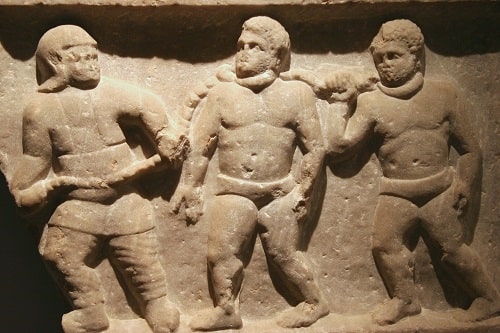
Slavery was indeed abusive and very demeaning and threatened human existence. Romans had a birthright for enslaving a person divided into two categories, public and private.
Public Slaves, also known as Government-owned slaves were condemned to serve in projects of national interests, while private slaves did individuals.
A wealthy man could enslave as many as 500 people; meanwhile, emperors would keep more than 200 people.
Roman slaves were Greek, held captive during the massive battles like the Punic war and Pyrrhic war between Greece and Rome during 100 BC.
Ancient Greek and Roman civilizations dominated most of the European boundaries. A clash between these potent realms changed European history forever.
During the late Hellenistic period, the Roman Republic was spread across three-quarters of the Italian peninsula and Sicily, Sardinia, and Corsica as the only external territories. Similarly, Greece dominated Macedonia, the North African coast.
Alexander the Great, one who never faced defeats, extended the boundaries of the Greek empire from Macedonia to Egypt and From Greece to India.
But after the demise of Alexander the Great, capricious and unpredictable King Philip V. Scion succeeded him.
Philips abided by a famous Greek saying, “a king who lived in peace was no king at all,” lost in managing political machinations plotted against him, little did he care about neighboring rivalries against Macedonia.
Several Greek colonies like Byzantium, Herakleia Pontike, Sinope were not entirely loyal to Greece.
The internal conflicts among smaller Greek nations broke down the sense of unification, so these states lost their significant powers compared to a neighboring empire like the Romans. They grew increasingly in terms of power, size, and trade.
The major war declared against the Greek community was through the Battle of Corinth in 146 B.C., while the Romans gradually took over each independent Greek state.
The victory over Corinth loosened the Archean league, which unlocked further conquests. The primary motive behind the win was to prevent King Philip from alliances against Roman interests.
Macedonia was occupied at the second battle of Pydna just after the outbreak of the second Punic war.
Gradually, the Roman triumph over Greek cities continued until 27B.C, until the entire Greek peninsula was under the Roman regime.
Augustus Caesar converted it into the province of Achaea; however, Greek culture remained prevalent. Greek slaves were influxed into the Roman empire after the victory.
The war prisoners, sailors including men, children, and women, were Roman slaves—likewise, foreigners, sailors along with the people sold by the pirates.
Not only war victims but people accused of crimes were also pushed into slavery as well as the children born to enslaved people also had to serve as slaves.
Infants abandoned at birth or those sold by their parents, which was a rarer case, also contributed to slavery.
Men, women, and children all fell under the enslaved category where men served as manual laborers while women as house help.
Surprisingly, highly educated enslaved people could also be found who worked as engineers, physicians, accountants, etc.
Evolution of Slaves in Ancient Rome
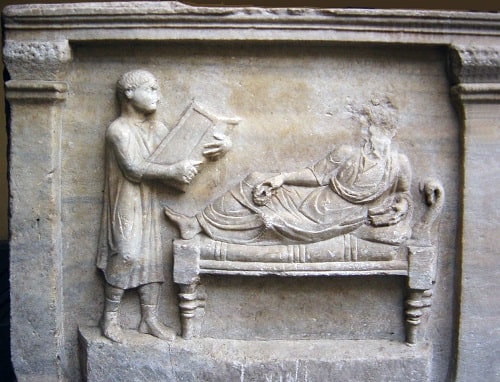
Romans were at war most of the time in an extensive desire to widen their boundaries. Victories would count as an influx of slaves from losing counterparts.
Most enslaved people were brought back from wars against Greece, a hotspot for slavery. As Ancient Rome stood on the banks of the Mediterranean sea, they had connections with seafaring pirates.
Pirates had a chief aim to gather as much wealth as possible so that they could descend to any extent, even human trafficking.
They would sell off people to Romans who kept slaves for ease. The relationship between piracy and Roman was mainly based on the slave trade.
Pirates would kidnap people offshore and ports to be sold as enslaved people. The Romans negotiated with them to aid their personal growth in economy, infrastructure, and luxury.
War victims and Romans also held foreign immigrants as captives irrespective of their age or gender. Females and even children born to enslaved people had to undergo the same fate as their parents.
During the Republican period between 509 B.C-27 B.C, Romans traded many enslaved people.
But after the end of 1st B.C, Augustus’s pacification of the Mediterranean caused a considerable reduction in enslaved beings.
In Imperial times between 27 B.C-476 A.D, Eastern European countries, Ireland, Scotland, Africa served as an important trade center for enslaved people.
Simultaneously, the Black sea area, Africa, Arabian Peninsula were also listed under importing hubs for slavery.
Rome’s invasion of Britain introduced skilled and literate people who had keen interests in music, arts, literature, etc.
Those people were the ones who drafted ideas for designing the Roman infrastructures, which stood upright for centuries.
The actual origin of slavery and their race was always regarded as a complex issue that could never resolve.
Treatment of Slaves in Ancient Rome

A person could be bought or sold just like any piece of furniture regardless of their wishes. Roman civilization had set up strange laws that anyone could keep slaves if it were their birthright.
Legal rights were not a thing for enslaved people as they were not allowed to marry. However, a domestic family could be established, but the couple could be separated anytime the master wished.
Children born to such a coalition were regarded as the master’s property who experienced similar lives as their parents.
Later on, the Law of Code of Theodosius in the 5th century was passed to reunite a slave family under the same master.
Enslaved men were employed to manage affairs of their masters, such as debt collectors, bailiffs, ship managers who could be to death if masters sensed dishonesty.
An ordinary Roman citizen was not exposed to any brutal sufferings; hence slaves had to serve for such odd jobs.
Contrary to low grading, slaves could perform some semi-independently, which gained their master’s trust. Physician, teacher, painter, potter were some reputable deeds performed by a qualified enslaved person.
Females worked at domestic levels attending the wives and mistresses of wealthy Romans.
Ancillae were subjected to verbal and physical abuse, such as prostitution, everyday practice, and even a nightmare for any lady slave.
They did not pass any law regarding the adoption of a child born to a slave by her master, but the master could free his child with a restriction on adoption.
Agricultural exposure was the dreadful place any enslaved person could end up. They were forced to mine in the sweltering heat, literally forced to death.
In addition, agricultural slaves were all chained up slept on heaps of straws that gave them irritation and rashes on the skin.
Being exposed to such humiliation, agricultural enslaved people were the foremost rebels against the system during 70 B.C.; however, mining slaves could not join the revolt due to a lack of physical strength.
Slaves were given slices of bread and cheap wines along with vegetable soups, porridge, and some meat.
The meal did not immensely nourish them, so they could not muster up the strength to fight against all the demeaning stuff done to them.
The life of slaves in the Roman era was no less than a death experience.
Masters killed them without any trial could be crucified on nails, planks, etc. They were stripped off, flogged to bleed, then nailed across planks.
Not satisfied with all the inhumane acts, Romans did not refrain from breaking off the legs and arms of slaves to give them acute pain.
Attire of Slaves in Ancient Rome
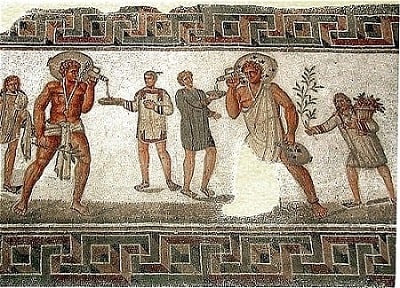
Enslaved people were deprived of all sorts of fundamental rights, so for sure, they would not be allowed to wear majestic clothes. Unlike their master, slaves had to follow a modest dress code per their labor division.
A slave sewist would sew all the types of clothing made out of cheap wool. They wore tube-shaped tunics with holes for arms held across the waist by a belt.
The tunic dropped down to the level of knees overlapped by a cloak. Roman citizens would wear Toga under their tunics, but enslaved people did not have the privilege to wear a toga.
Slaves were often bought at slave auctions, and owners dictated their dresses.
The quality of the fabric was dependent on the status of the master, so house slaves of wealthy owners wore better clothes than menial laborers.
Agricultural slaves wore loincloths who possessed no unique attributes. The employers provided them with wooden shoes every two years.
They were regularly shaved, and the hair was used to prepare wigs for wealthy Romans. Unlike those who mined or built canals, skilled enslaved people received better clothes.
Female slaves working as hairdressers were known as ornatrices, responsible for the creation of elaborate hairstyles received special favors.
Gladiators assigned for the battlefield wore subligaculum or loincloths that came in various colors. For unusual occasions, they also wore cloaks and were allowed to keep some of the battle winnings.
However, gladiators could not use armors, so they fought with bare chests.
Slaves had easily merged into the population as they resembled native Romans. The Senate once came up with an idea to prepare a particular clothing pattern to be easily differentiated.
However, the idea got rejected as they feared slaves would unite to revolt if they knew how large their number was.
Settlement of Slaves in Ancient Rome

A life of bondage was imposed on slaves who experienced living hell in ancient Rome. They were dragged into slave auctions, naked and humiliated, tied with a tag defining their features just like any good.
Private slaves worked at the residence of Romans as a cook, hairdressers, or even in small workshops for leather silver makings.
They lived in degrading dormitories or attics of the houses with no facilities.
A poorly lighted damp room with no proper ventilation was the typical home to slaves who experienced better lives. They slept in wooden chambers when they did not attend masters.
Mining slaves had even worse lifestyles with minimal food, piles of heavy works, and almost no rest at all. They had to sleep on heaps of straw beds under the open sky.
Ways of to get Freedom by the Slaves in Ancient Rome
Legal freedom was not in favor of enslaved people who could neither flee nor buy their space. However, a master could free his slave through manumission.
Enslaved people could be freed under three conditions: as per the wish of the master, being included in a census list, and by a lawsuit in the presence of a magistrate.
Once set free, enslaved people converted into Roman citizens but were not eligible to hold public posts.
Manumission could grant them freedom if assets were paid back to the master. But owners never gave incentives, so it was nearly impossible to buy one’s liberty.
Freedmen of freed women were also subjected to abuse and degradations.
Women could get married to any Roman citizen to free themselves; nevertheless, such marriages resulted in more male control.
Legitimate children through such alliances were allowed with full dignity in the society. The freed-wives held low prestige and degree in comparison to non-freed spouses.
Freedom was to be given in the presence of a magistrate in a formal procedure known as praetor.
The master or mistress gave a cap as a signal of liberty and new status to the enslaved.
Life after freedom
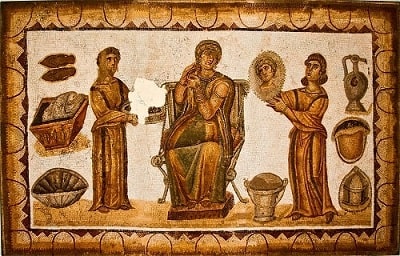
Freedman would resume his life as an ordinary citizen with his former master as a Patronus. Despite grant freedom, the person had to work at the master’s place for several days annually, supporting their progress.
Disrespectful behavior towards the master could revoke slavery; hence liberation was always conditional in ancient Rome.
They would earn their living by the skills learned while working as an enslaved person with no limit to fortune and success.
Trimalchio was a perfect example of a rich yet uneducated freedman in Satyricon, a novel by Petronius.
Despite the release from bondage, natives never respected enslaved people. Romans permanently disgraced, avoided, and forbade them from being part of public posts.
But the children born after the liberation were eligible to enjoy every right, unlike their parents.
Cost of Slaves in Ancient Rome
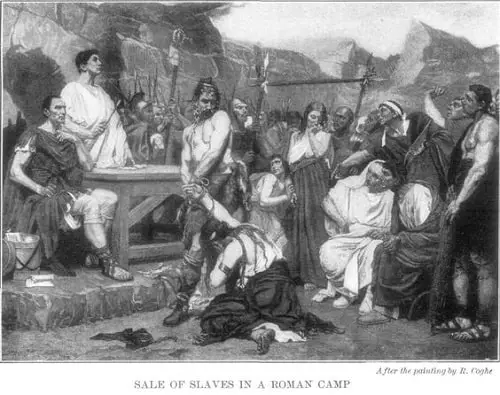
Enslaved individuals were categorized into different monetary classes at the auctions based on their age, gender, skills.
The average price for an enslaved individual was approximately around 2000 sesterces in the first three centuries.
Enslaved men would cost about 500 denarii, whereas females would go up to 6000 denarii. Slaves would not be given incentives, but masters who paid deducted ration, boots, hay costs from the payrolls.
Proficient workers would cost considerably much higher than others.
More significant funds were required to trade slaves, so Romans considered their maintenance.
Gladiators who went on wars suffered loads of physical traumas that had to be looked after carefully as they were responsible for the defense of Rome.
The loss of a gladiator would massively affect military reinforcement, so it was considered a horrible calamity.
The enslaved people were worth their weight in gold silver and had to be maintained well for the reputation of the master.
Owning a gladiator caused great fame and fortune to both masters and enslaved ones.
Some Romans intentionally sold themselves to pay off the debts of gain popularity.
Impact of Slavery in Economy of Ancient Rome

Enslaved people played a vital role in shaping the ancient Roman economy. They worked in every possible sector, including arts and architecture, medicine, agriculture, mining, warfare, etc.
Selling and purchasing slaves brought drastic modification in the economy between Rome and its competent.
Romans sold adept individuals at higher wages who could contribute to advancement while paid menial ones paid much less despite their efforts.
Well-educated slaves were capable of teaching children that boosted education. They had efficient knowledge on maintaining a house, aiding the housing economy.
On top of it, small workshops where luxury goods like coins, utensils, jewels were made managed to balance profitable Roman trade.
Primary agricultural cultivations were millet, wheat, and emmer, spelled that reflected in the Roman meals.
Merchants sold off cash crops and food crops like barley, lintel, peas to neighboring empires in exchange for cash. Likewise, Romans also exported grapes, olives, wine, and cereals to Europe.
Beneficial agriculture would certainly strengthen Rome’s economy, whose major credit went to slave labor.
The city-owned enslaved people excelled at building attractive infrastructures. Pantheon, Pont du Gard, Liberty of Celsus had been constructed under slave exertion in ancient Rome.
Solid and resilient monuments that could stand for centuries would reduce the cost of multiple reconstructions.
Teachers, physicians, accountants were high-profile enslaved people. Educated tax collectors helped in the timely collection of tariffs invested in other national glory projects.
Similarly, mini slaves extracted raw materials from ores that traders exported.
Slave Rebellions in ancient Rome
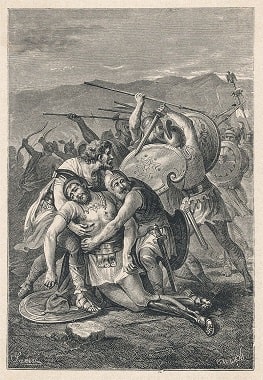
The Servile Wars were the slave rebellions in the Roman Republic having a series of three wars. The charismatic leaders led the revolt who considered themselves worthy of predicting the future.
Leaders believed they possessed supernatural powers, so the future prediction was a piece of the pie.
Frustration led to riots that eventually came out as the first session of the Servile war in the second century in Sicily.
In five years, Eunus, an enslaved Syrian, convinced his fellow mates that Goddess Atargatis had ordered him to lead a protest against starvation and abuse on them.
He had excellent oracular abilities, which he presented proudly, producing fire from his mouth.
The trick persuaded other enslaved people to follow Eunus’s path, set out to murder masters, ablaze their homes, and destroy Roman villages.
Around 60,000 people participated in the movement to declare Eunus as their king.
But the Romans got hold of them as a result of which Eunus got crucified, and others were also tortured to death.
The second riot of the series originated in Sicily itself thirty years later.
Salvius led the troop with 80 rebels and reached 20,000 followers in no time. Attention, a man who claimed to have a good grasp of astrology rose to stardom after giving few accurate future predictions.
The duo created large-scale devastation, but the Roman army crushed them during the following four years. Many died on the battlefields, and those who survived met a harsh fate.
A gladiator who fled from his school led the final slave rebellion in 73 B.C. Spartacus, once a freeman, was enslaved and sold to a gladiator school owner.
His wife was a prophetess, so she spread stories of snakes coiled up on Spartus’s neck to prove his divine.
Men, women, and even children got involved in this movement and received similar destiny as the former rebels.
Conclusion
Slavery never came to an end in Rome, prevalent in both Republic and Empire Rome. The Roman civilization ceased before slavery which continued till the 19th century.
Slave traditions benefited ancient Rome in many aspects, like the agriculture economy.
After the victory over its rivals, they had been brought to Rome and resided as a part of the Roman property. The Lives of enslaved individuals were harsh and miserable.
Being exposed to verbal physical exploitation and being pressured to work in the scorching sun with a minimal amount of undernourished food, slaves encountered near-death instances.
Several revolutions also originated, but in vain; they could not resist the mighty Roman Armies. Extreme desire to flee and gain freedom always prospered within them.
Luckily, few masters granted liberation to their slaves. However, the social restriction was never uplifted completely.
